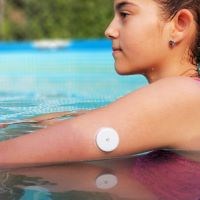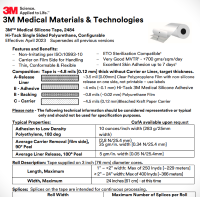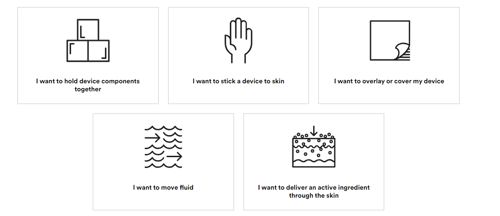Silicone Adhesive Tapes for Wearable Medical Devices
A Q& A Session with 3M scientist, Audrey Sherman
It’s no secret that there is quite a lot to think about when designing a skin-contact medical device. And while the adhesive that attaches the device to the skin is only one of many considerations, it is incredibly important that individuals involved in the research, design, or production of wearable medical devices understand the different adhesive options available—which is why we have so much content on this site about adhesives and adhesive selection.
At JBC, we know die cutting. Really well. We also know tape—but nowhere near as well as the experts. So, when we decided to do a Q&A post about silicone adhesives, we turned to one of the most respected materials scientists in the business: Audrey Sherman, a division scientist in the 3M Medical Solutions Division, now known as Solventum, with over 100 patents to her name.
If you want to learn more about silicone adhesives, you couldn’t have come to a better place.
Now let’s talk silicone...
So, where should we start?
Before we get into why die cut silicone adhesives are so effective for short term wearable device applications it is important to understand the science behind how they work.
Unlike acrylate and synthetic rubber adhesives, both of which are carbon based, silicone adhesives are based on silicon, an inorganic synthetic polymer.
|
Silicon is underneath carbon in the periodic chart, which in simple terms just means that it has one more shell of electrons and has a larger atomic structure than carbon. This means that the atoms or molecules it bonds with cannot get as close together as they would when bonding with carbon. Put more simply: silicone has more space in between atoms that attach to it than carbon does — and that space gives you a much more flexible molecule at an entire range of temperatures. |
How does this information translate into the performance properties of Silicone Adhesives being different than an acrylate or synthetic rubber?
Because of its chemical makeup, silicone has all that extra space between atoms which makes silicone adhesives more flexible than acrylates or synthetic rubber adhesives. It is also the only polymer that is hydrophobic, meaning water beads up on it. Yet, because of its atomic spacing and structure, it WILL permit the passage of gas molecules – including water vapor. There is no other polymer that does both.
You could almost say there is a superhighway through silicone for water... which makes it ideal for medical adhesive applications that require breathability.
What are the top 3-5 wearable device applications that require silicone adhesives that the performance benefits of a silicone adhesive outweigh the additional cost?
The top three applications that I can think of off-the-cuff are continuous glucose monitoring devices, wearable heart monitoring devices, and respiration/ pulmonary sensors. But these are only a few. There is such a trend right now to get rid of the wires and collect data in real life/ real time so that people aren’t so tethered.
Why do you suggest silicone adhesive tapes are best for these three applications?
There are a couple of reasons that silicone adhesive tapes are ideal for these applications. First, they are skin-friendly. They are inorganic, so our carbon-based bodies don’t react to them like other organic materials. No matter your skin type, most people are probably not going to get a huge allergic reaction to a silicone adhesive.
Secondly, due to the chemical makeup we discussed earlier, silicone does not care what the temperature is, or what the environmental factors are. Because it is already a liquid at room temperature and above, it is so much more durable on the body. It will maintain adhesion in all kinds of situations. It will remain temperature neutral and perform the same whether you are in the shower, running a race, working out, sleeping, or just cooking dinner.
The caveat would be the length of time those devices need to be worn. For example, if your product is intended to be worn for a longer period, an acrylic adhesive is the most common choice.
How much is the need for a silicone adhesive tape driven by the application vs. the age of the skin?
It is really a little bit of both. Age matters because skin is a living, breathing, evolving, organism. The very young and the incredibly old tend to have more sensitive skin than do those in the middle stages of life. As a result, the wrong adhesive attached to a neonate will cause severe discomfort upon removal, and the wrong adhesive attached to old, brittle skin will not just cause maceration, it can also cause trauma. Silicone adhesive tapes truly excel in those extreme scenarios.
| The application also matters – specifically because it is not always about the skin itself, but what the skin is experiencing. The activity levels it is being exposed to. The sweat. The movement... and where on the body and the length of time it needs to be worn – and if it will need to be repositioned during use. Once you reposition an acrylic adhesive it starts to pull up the skin cells and then it becomes less tacky whereas with silicone you could reposition it three to five times before losing adhesion properties. |  |
How important is the carrier/tape backing to the overall performance of the tape?
When you think about it, these adhesive tapes are really a system that is made up of both the adhesive AND the carrier. One side of double-sided tape is the interface with the skin, the other side attaches to the device, and the carrier is the layer that sits between device and the skin adhesive. That means that the carrier’s properties come into play because part of the system that starts with the skin and ends with the device. For example, it won’t really matter how breathable or flexible the adhesive is, if the carrier is impenetrable or stiff.
Are there any specific tapes you would recommend for these applications?
Honestly, every customer application is slightly different, so we try to avoid general buckets when at all possible and instead direct people towards our adhesive selection tool: Find My Adhesive. Once customers have narrowed down options, we also strongly recommend that they work collaboratively with their converter and 3M representative to get samples and prototypes for trials.
Silicone adhesive tapes typically come with a higher price tag. Talk about how and when the performance benefits of silicone outweigh the costs.
When you think about it, the cost is relative.
For example, silicone adhesives have much better repositionability than their acrylate and synthetic rubber counterparts. When you can reposition a solitary product rather than using and throwing away three or four “less expensive” products, the value is certainly there.
You also need to consider that the effectiveness of any wearable device hinges on its ability to remain securely attached for the entire prescribed duration. If the device falls off, or the patient peels it off because it is adversely affecting their skin, that's a big problem. If the adhesive is irritating and the patient is not going to wear it, the cost is irrelevant.
Due to its flexibility and pliability, many people do not consider silicone adhesive a strong choice for affixing a device to the body for any long time. Can you talk about the solutions that 3M has created to address this issue?
Absolutely. What you are referring to is our high tack silicone adhesives. These products have all the benefits of silicone, but with enhanced shear performance, greater tackiness, stronger adhesion, and extended wear duration. They are ideal for applications where there is a need to adhere a device to a sensitive area of the body.
|
 |
When do we NOT want to use silicone adhesive?
From a performance standpoint, I cannot think of a place other than extreme long-term wear where we would not want to use silicone. It is just so flexible. From a business perspective, obviously when you have a really low-cost competitive situation where silicone isn't necessarily needed, you probably won't go with silicone because you are not getting silicone’s whole value.
Thanks for Reading!
Think JBC Technologies for Custom Die-Cut Skin Contact Tapes
With two ISO 8 / Class 100,000 cleanrooms, state-of-the-art rotary die cutting equipment, inline printing and a whole host of other converting capabilities, JBC Technologies provides high-quality solutions for the medical industry – from CGM patch overlays, electrodes, and wound dressings to custom fashion and cosmetic tapes.
Want a custom-printed design on your medical tape? Just Ask. JBC is here to deliver.
Contact us today to learn more about how we can help you with your medical device manufacturing needs.

